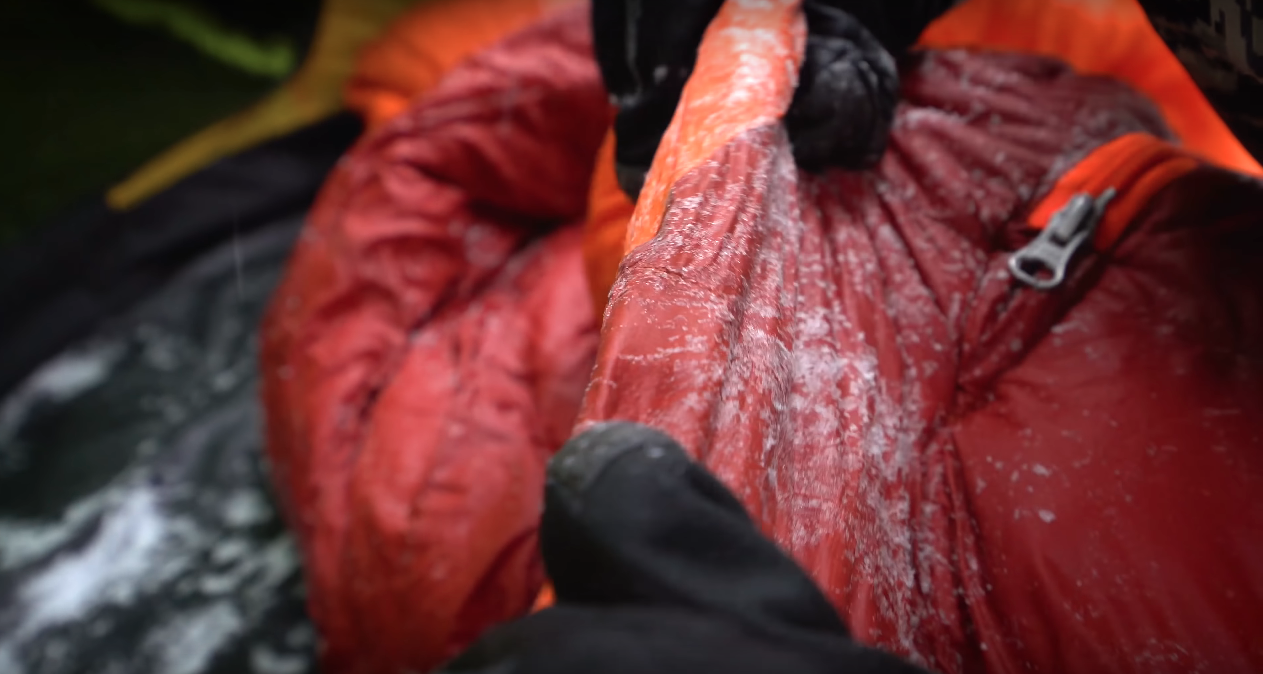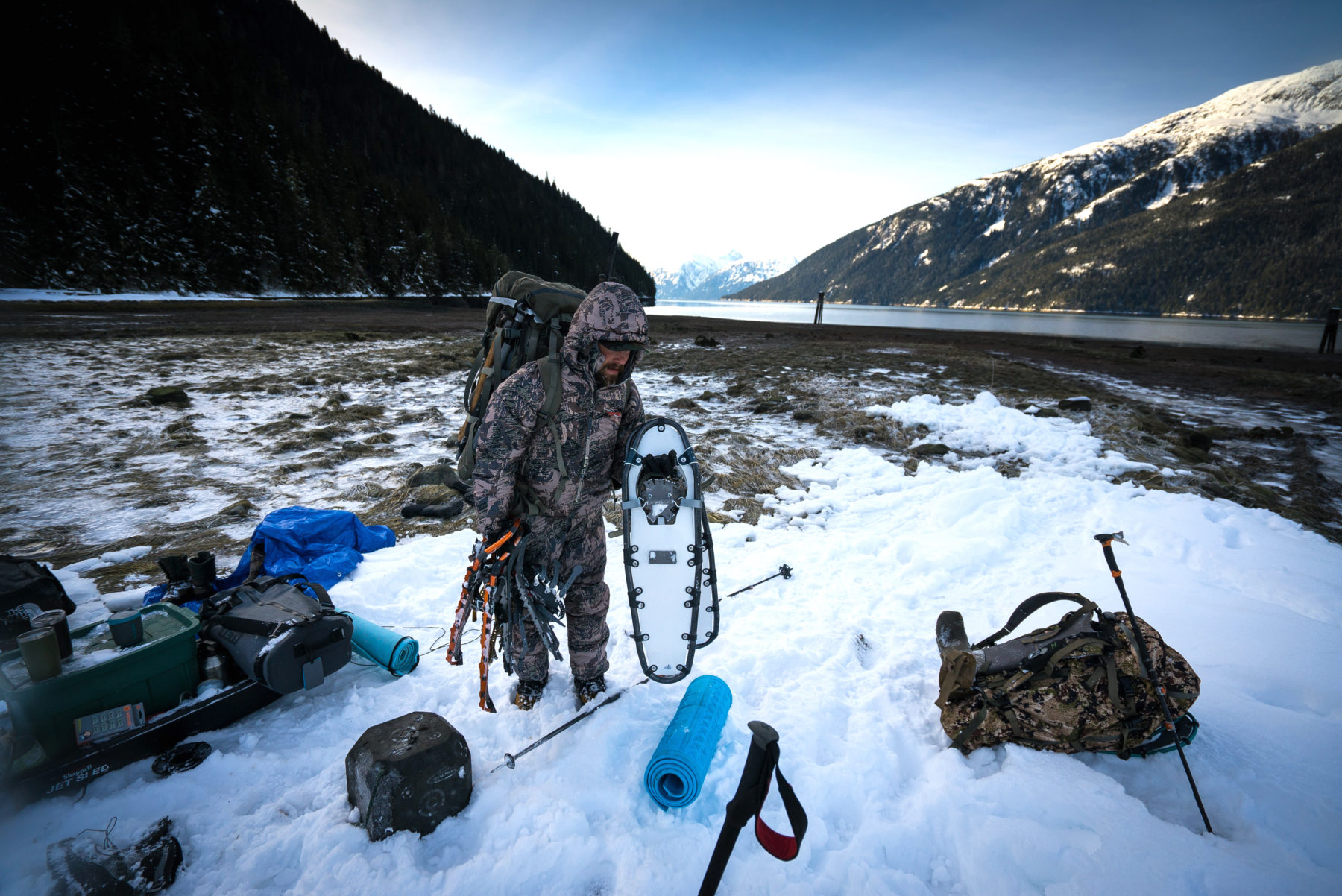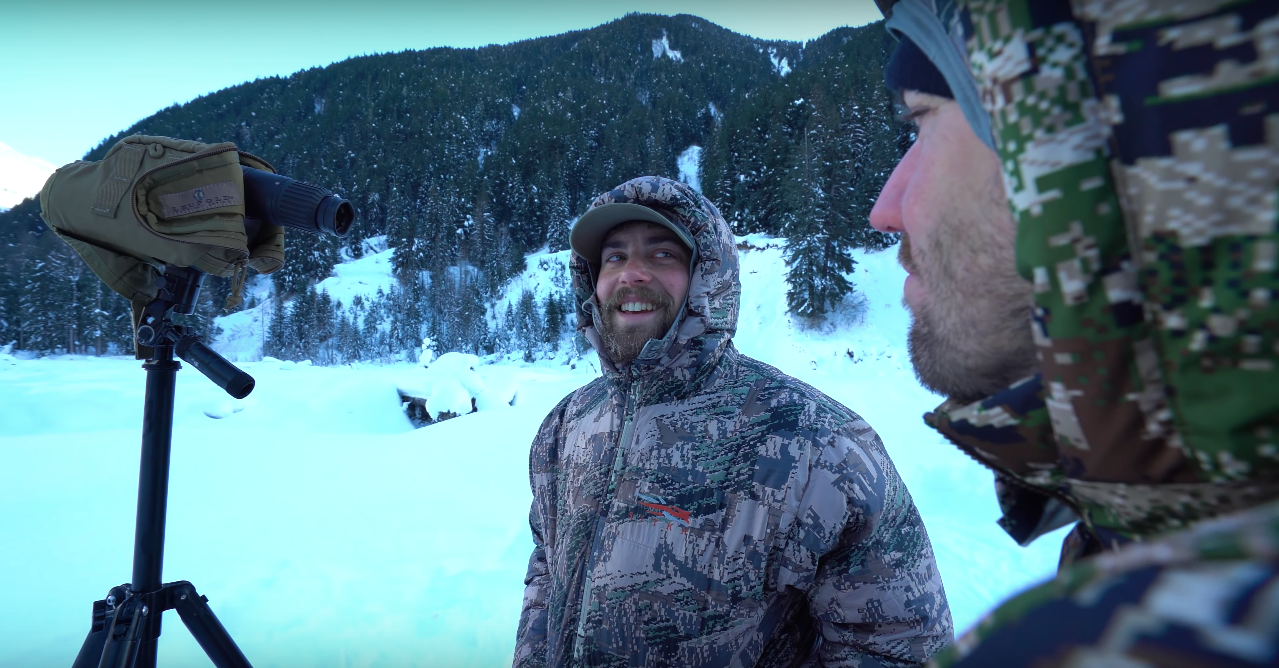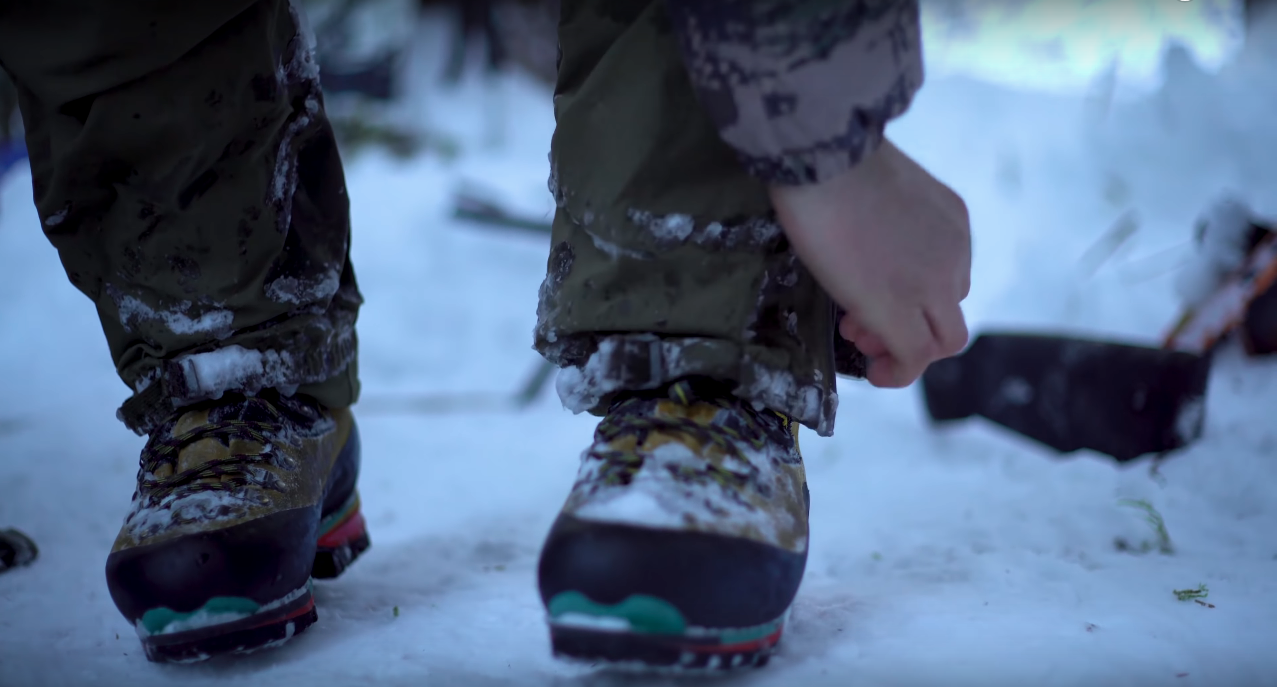Winter has sunk its icy talons deep into the mountains of Western Canada. Even the lower elevations of the South Coast of B.C., normally temperate and devoid of snow through winter months, are cloaked in white. For many, the plummeting temps and snows of the late – late – season mark the last dying breaths of fall’s hunting. However, as some of you know, deep snow and cold temperatures don’t mean that your season needs to be over. Many parts of Western North America have late-season tags — either draw or OTC — and some of these hunts are what I like to consider diamonds in the rough.
It should come as no surprise to anyone who has been a long-time reader, that I am alluding specifically to the winter mountain goat hunting opportunities that are available in British Columbia and Alaska. This will be my fourth trip in five years, and while it’s fast become a go-to winter pilgrimage, this isn’t the only hunting opportunity in British Columbia that will routinely see snow and temperatures well below freezing. Any trip in B.C.’s mountains from the start of October onward holds a chance of winter weather, and it’s not uncommon to have lakes frozen solid by this time in the Northern portions of the province.
Late season hunting in the mountains comes with its own unique challenges. In many ways, the gear management principles you’d apply in the early season are still valid, but constant sub-zero temperatures add a layer of complexity. The insignificance of knee-deep creek crossings in August becomes carefully calculated, and potentially dangerous when it’s -20º C in the backcountry. Needless to say, but a thorough understanding of potential risks and safety-oriented decision making are critical during these months, with the added risk of weather-induced ailments — hypothermia, frostbite — and avalanches being of primary concern.

2019 February Billy. Photo: Trousdell Media
Despite the opportunities available to hunt Elk, Bison, Sheep, and Goats in some areas, many hunters seem to be nervous about dealing with frigid temperatures and deep snow. It seems that we continually get asked about packing and gear specifics for these kinds of hunts, so I decided to do a “Pack Dump” for an upcoming mountain goat hunt, in hopes that it might provide insight to those hunting in sub-zero temps.
The key to making these hunts as enjoyable as possible is through moisture management — achieved by understanding and applying base layers. As I have already laid out the groundwork for understanding layering systems in the article “Cold Weather Layering Systems”, I don’t feel it is necessary to spend much time on this subject. Dry = Warm, Wet = Frozen, the faster you understand this the happier you are, pretty simple in theory.
One final note on this before I go through my pack, and this is something that I cannot overstate. The majority of these items are subjective choices. As you spend time in these situations you will gain a better understanding of your needs and comfort zone, as well as fine-tune your “system.” This list is something that I have cobbled together over the course of my experience, but personal preference may steer you in a different direction. Experimenting with different set-ups can be an enjoyable process, so long as you don’t wind up unprepared and putting SAR-tech’s at risk. It is also important to mention that this gear list is incredibly expensive, and certainly not within many people’s budgets. As a guide in remote places, you find out quickly that quality trumps just about everything in the field — you can’t drive back into town from camp to replace an item if it fails on you in the field. This gear list is meant to be an example that you can use for reference and in no way a list of things you must purchase to be successful in the field. Good gear does not make you a better hunter, only a more comfortable one.
Rifle and Optics:
If we avoid the semantics around suitable cartridge selection for any given mountain hunt, this is pretty straightforward. Rifle, optics, and support system for said rifle. A flat shooting, weatherproof, bolt action with a medium power scope that has exposed elevation turrets is the key here. Not all rifles are created equal as we know, and I have had a different bolt action freeze on me during a past hunt – moisture management rules apply here as well – but there are a variety of solid options to suit all budgets. My thoughts on that are more specifically covered in Mountain Ready Rifles.
- Gunwerks Clymr Ti 6.5PRC
- Leupold VX-6HD 3-18x44mm CDS-ZL2
- Leupold Mark 4 Aluminum Rings
- Atlas Bi-Pod V8
- Swarovski EL Range 10×42
- Swarovski ATS HD 65mm
- Sirui A1205 Tripod
- Gunwerks 147gr ELD-M Ammo
- Sitka Gear Bino Harness
Pack + Essential
Whether guiding or hunting for myself, I rarely go anywhere without my pack on, as it carries my basic daily – weekly needs. Pack size can be scaled up and down depending on the goal of the day, but there are always a few items that permanently reside in my pack.
- Mystery Ranch Marshall
- Medical Kit
- Toiletries Bag – A small Sil-Nylon Zippered bag like Outdoor Research Zip Sack works great.
Electronics Bag – Small sil-bag to hold electronics/cables, battery packs, etc.
- Delorme Inreach
- Petzl Bindi Backup Headlamp
- USB Battery pack
- Goal Zero Lighthouse Mini
- MicroUSB & iPhone cables
Kill Kit – Small sil-bag to hold all necessary items for processing animals
- Gerber Vital Folder & replaceable scalpel blades
- Lighter x2
- ZipCube Firestarter – 1 Cube per day
- Gerber Multitool
- 550 Paracord – 50ft
- Nitrile Gloves
- Game bags
- Lipchap
- Small packet of wet wipes – great for wiping blood off for photos
- Electrical Tape
- Petzl Reacktik+ Headlamp
- License & Tags
Outerwear
Typically you are looking to create a barrier from snow instead of rain in these situations, which I feel gives you leniency in your choice of rainwear. Durability, ventilation & range of motion are going to be my priorities at this time of year, as I expect very little rain. Find a set that suits you, and roll with it. As always function over fashion — don’t get too hung up on the brand, color, or camo pattern, you can always wear a white painter’s suit overtop if you are hunting in the snow. I like to keep a few options for gloves on me, they don’t weigh a ton and are bound to absorb moisture at some point. Shell Gloves with removable fleece liners seem to work the best for wetter environments. Winter Mountaineering boots are the go-to, and while my feet generally run warm, you may find yourself looking to the 6000m boots offered by companies like Scarpa & La Sportiva to combat frostbite.
- Kuiu Yukon Rain Jacket & Pants
- Arcteryx LEAF Cold WX glove
- Arcteryx Alpha SV Mitten
- Fleece Liner Glove
- La Sportiva Nepal GTX – well treated with Obenhaufs paste.
Insulation
This is another topic that the Journal of Mountain Hunting has been very vocal about in the past. Late – Coastal Goat hunting often brings mild temperatures and heavy wet snow, as well as moisture-laden creek bottom campsites. Synthetic insulation reigns supreme in these situations, though treated down can have its place.
- Sitka Kelvin Down WS – 70% treated down 30% synthetic insulation, an oversized fit, and super warm jacket. This piece is a go-to of mine any time the mercury drops.
- Sitka Kelvin Lite Pant – Currently discounted, Beyond Clothing A7 – Cold Pant would be comparable.
- MEC Expedition Plus Booty – Synthetic insulated weather-resistant slippers. Pretty nice to get out of the boots in the evening around the tents.
* If weather is consistently colder than -20º C I will pack another lighter-duty down or synthetic layer (Kuiu Superdown Hoody or Arcteryx Atom AR) Warmth to weight ratio beats any other mid-layer.
Baselayer
The principles around this have been covered in the Cold Weather Layering Sytems article I mentioned previously. Cold weather backpacking brings an increased pack weight and bulkier items. Understanding layering, and how your body reacts to colder temperatures is key to avoiding unnecessary gear additions. Hunting pants aren’t necessary, a long underwear baselayer under raingear is suitable for continuous movement in sub-zero temperatures, paired with an insulated “down style” pant when you stop to glass. Softshell’s don’t have a place here, as their warmth to weight ratio is poor and waterproofing is weak.
- Outdoor Research Echo Hoody or Lulu Lemon Metal Vent Longsleeve
- Sitka Core Heavyweight Hoody
- Sitka Core Heavyweight Bottom
- Icebreaker Merino Boxers x2
- Smartwool Mountaineer Merino Sock x2
Sleep System
A quality four-season tent designed for demanding conditions is the lynchpin here. They are designed to keep snow out and heat in, and won’t buckle under a healthy snow load. Hilleberg’s Soulo & Akto are the ultimate solo tents for a dugout mid-mountain campsite in deep snow. I am a big fan of synthetic sleeping bags for their worry-less versatility in damp conditions, and they don’t hurt the wallet either. Thermarest Neo-Air XTherm is one of the lightest and warmest pads on the market. It comes with a hefty price tag, but sleep is precious.
- Marmot 0º F Synthetic Sleeping Bag
- Thermarest Neo-Air XTherm
- Hilleberg Akto + Floor
- Hilleberg Nammatj 2 GT (2 person hunt)

Moisture laden creek beds = frosty sleeping bags
Cooking
It is worth saying that the average fuel canister stove system isn’t designed to operate in truly frigid temperatures – low pressure means slow burn time and difficulty achieving full stove power. MSR’s Windburner, Reactor, and Pocket Rocket are pressure regulated stoves, which means they still work well when it’s -25º C.
- MSR Windburner Duo
- MSR ISOPro Fuel Cannister 450gr x2
- Ti Longhandle Spoon
- Aluminum Mug
- Bic Lighter x2
- MSR Dromedary 6L
- 1.5 L Nalgene x2
Food
This is one of the single largest areas you can shave weight out of your pack – but as with anything it will come at a cost. I don’t typically count calories when backpacking, as I have a pretty good understanding of how much food I need to feel good and pack accordingly, however, I will keep track of them for winter hunts. Try to focus on foods with less refined sugar and more protein and fat. Mountain House is an old classic, however, it’s nice to cut back the salt and get into some real food in the backcountry. Last year I was the most dialed in I have been with regards to food and calorie counting, and I managed to get my food down to around 1.3lbs per 3500 Cal. Depending on how much climbing you do, and how cold it is, your food needs may vary. This is a typical daily amount for high exertion for long periods in cold weather, multiply by the number of days in the trip and scale up or down amount as you see fit.
- Offgrid Food Predator Fuel Oatmeal – 660cal
- Offgrid Food Jerky – 210cal
- Offgrid Food OG Trail Mix – 740Cal
- MoonCheese – 326cal
- Honey Stinger Waffle x2 – 340cal (2)
- ProBar Superfood Almond Butter – 190cal
- Clif Shot Block – 100cal
- Offgrid Food Thai Green Curry w Quail – 950cal
- Instant Coffee & Tea bags
Misc Gear
These are more specialized items I may or may not use but intend to bring on this coming hunt. These items often get switched out depending on what I am hunting and the time of year. Ropes and a harness are a good idea for hunting in the winter months, but it is important to understand how to use them. Be careful not to use them as a crutch to help get yourself into a situation that you can’t get out of.
- Grivel G10 Crampons
- Petzl Ride Ice Axe x2
- Petzl Tour Harness
- 30M Rope
- Carabiner x2
- Snowshoes
- Gerber Hatchet
- Hiking Poles
While I’ve never weighed this list, all in this pack should weigh somewhere in the 70-80lb range. Heavy enough to know its there, but not bad for a gear intensive 10-day backpack hunt in the snow.






